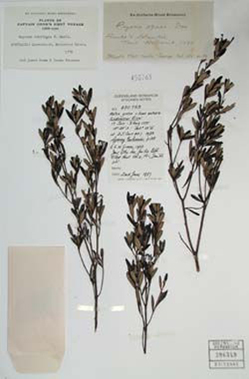Our specimen collection

The Queensland Herbarium houses the state’s flora collections, comprising more than 911,000 specimens, and associated data, of mainly Queensland species of plants, fungi and algae. The Queensland Herbarium collections are internationally recognised with Index Herbariorum under the code BRI. The Queensland Herbarium is a CITES registered institution.
Botanists and members of the public contribute thousands of specimens to the herbarium collection each year, helping to document new species, new naturalisations, and new distribution records of both native and naturalised plant species.
Herbarium specimens are mostly pressed, dried and mounted on archival cardboard. Delicate or small specimens are stored in jars of liquid preservative. Fungi and large woody specimens are stored in boxes or bags.
Each specimen is labelled with the collector, date of collection, location, habitat information, and the plant’s features, such as bark and flower colour. This information is recorded in a database and is available through the Australasian Virtual Herbarium.
Find out how to collect specimens (PDF, 3.5MB) to make sure the specimens are collected, preserved and submitted to our requirements.
Accessing the Queensland Herbarium collections
The Queensland Herbarium specimen and library collections are located at the Brisbane Botanic Gardens, Toowong and may be accessed by bona fide researchers. Requests for research access should be addressed to the Director prior to beginning your project Contact us via Queensland.Herbarium@qld.gov.au for more information.
Specimen loans and donations
Specimen loans may be approved to scientific institutions. Requests for loans, including requests for destructive sampling, should be addressed to the Director. Loan conditions and other information will be sent once the request is approved.
Donations and exchange specimens are welcome by prior arrangement. Please contact us first to ensure legal and safe transfer of specimens.
What is a voucher specimen?
Voucher specimens are specimens collected to support a research project or a particular activity, for example they may represent new weed incursions, seed collections, ecological research, DNA sequences or biochemical analyses.
If you are required to lodge voucher specimens as part of your research, please contact us before beginning your project to discuss the requirements.
Acceptance of voucher specimens will be assessed on a case-by-case basis. We can only accept voucher specimens that:
- are associated with bona fide research, that has ethics approval (if required)
- are collected in Queensland (native or naturalised, usually not cultivated)
- are legally collected with appropriate permits or permissions documented
- meet the Queensland Herbarium quality standards, including data. Contact us regarding our policy for accession of plant specimens into the Queensland Herbarium collections.
Please note that cost recovery for processing and storing voucher specimens may be applied.
What is a type specimen?
Type specimens are those permanently associated with the published scientific name and description of a newly described species. The allocation of Type specimens is an important part of how species are described. New species are published under international rules that help standardise botanical name use across the world.
The Queensland Herbarium houses more than 10,000 Type specimens. Images of these specimens are available on the JSTOR Global Plants website as part of the Global Plants Initiative.
Significance of the collections
The Queensland Herbarium specimen collections form the basis of our knowledge of the state’s species and plant communities. The specimens and their label data are an essential resource for species identification, management, conservation, and legislation.
Specimen data can be used to track species’ changing distributions and to predict where new populations may yet be found.
Our collections also include many historically important specimens, including those collected by:
- Joseph Banks and Daniel Solander during Cook’s voyage along eastern Australia in 1770
- explorers Robert Brown, Ludwig Leichhardt and Amalie Dietrich
- early Queensland botanists Frederick Manson Bailey, Cyril Tenison White and Leonard Brass.


